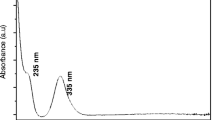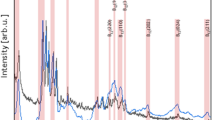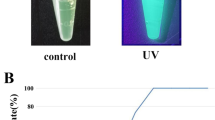Abstract
Carbon nanotubes (CNTs) have been increasingly more prevalent due to their use in product technology owing to their exceptional electrical and thermal conductivity and tensile strength because of their nanostructure and strength of the bonds among carbon atoms. The potential increase of CNTs in the environment is a concern, and studies to assess the toxic effects of these nanomaterials (NMs) are needed. However, so far, most of the studies are focused on aquatic species and much less is understood about the effects of NM in terrestrial organisms. This investigation used a functionalized multi-walled carbon nanotube (f-MWCNT) and the Jamaican cricket Gryllus assimilis to assess the effects of this NM. Cricket nymphs were injected with f-MWCNT suspension—at three different concentrations. The insecticide Fipronil was used as a positive control. Survival was monitored, and histological analysis was made in the brains. Pyknotic cells were quantified in two brain regions, a neurosecretory called Pars intercerebralis (PI), and an associative region called mushroom body (MB). No mortality was observed in any f-MWCNT concentration tested. A significant increase in pyknotic cells was observed as sub-lethal effect for the intermediate concentration of f-MWCNT, at PI, while any significant change was observed at the Kenyon cells of the MB. These results are discussed in the context of agglomeration and dispersion of the f-MWCNT at different concentrations, and availability of the f-MWCNT on the circulatory system, as well as the natural decay of pyknotic cells with time and different patterns of adult cricket neurogenesis. Our results showed that f-MWCNT had negative effects in the neurosecretory region of the brain.




Similar content being viewed by others
References
Agui N, Granger NA, Gilbert LI, Bollenbacher WE (1979) Cellular localization of the insect prothoracicotropic hormone: in vitro assay of a single neurosecretory cell. Proc Natl Acad Sci 76:5694–5698. https://doi.org/10.1073/pnas.76.11.5694
Akhavan O, Ghaderi E, Akhavan A (2012) Size-dependent genotoxicity of graphene nanoplatelets in human stem cells. Biomaterials 33:8017–8025. https://doi.org/10.1016/j.biomaterials.2012.07.040
Akhavan O, Ghaderi E, Hashemi E, Akbari E (2015) Dose-dependent effects of nanoscale graphene oxide on reproduction capability of mammals. Carbon N Y 95:309–317. https://doi.org/10.1016/j.carbon.2015.08.017
Allegri M, Perivoliotis DK, Bianchi MG, Chiu M, Pagliaro A, Koklioti MA, Trompeta AFA, Bergamaschi E, Bussolati O, Charitidis CA (2016) Toxicity determinants of multi-walled carbon nanotubes: the relationship between functionalization and agglomeration. Toxicol Rep 3:230–243. https://doi.org/10.1016/j.toxrep.2016.01.011
Alshehri R, Ilyas AM, Hasan A, Arnaout A, Ahmed F, Memic A (2016) Carbon nanotubes in biomedical applications: factors, mechanisms, and remedies of toxicity. J Med Chem 59:8149–8167. https://doi.org/10.1021/acs.jmedchem.5b01770
Athanassiou CG, Kavallieratos NG, Benelli G, Losic D, Rani PU, Desneux N (2018) Nanoparticles for pest control: current status and future perspectives. J Pest Sci 91:1–15. https://doi.org/10.1007/s10340-017-0898-0
Balasubramanian K, Burghard M (2005) Chemically functionalized carbon nanotubes. Small 1:180–192. https://doi.org/10.1002/smll.200400118
Benelli G (2016) Plant-mediated biosynthesis of nanoparticles as an emerging tool against mosquitoes of medical and veterinary importance: a review. Parasitol Res 115:23–34. https://doi.org/10.1007/s00436-015-4800-9
Benelli G (2018) Mode of action of nanoparticles against insects. Environ Sci Pollut Res 25:12329–12341. https://doi.org/10.1007/s11356-018-1850-4
Benelli G, Pavela R, Maggi F, Petrelli R, Nicoletti M (2017) Commentary: making green pesticides greener? The potential of plant products for nanosynthesis and pest control. J Clust Sci 28:3–10. https://doi.org/10.1007/s10876-016-1131-7
Bottini M, Bruckner S, Nika K, Bottini N, Bellucci S, Magrini A, Bergamaschi A, Mustelin T (2006) Multi-walled carbon nanotubes induce T lymphocyte apoptosis. Toxicol Lett 160:121–126. https://doi.org/10.1016/j.toxlet.2005.06.020
Bullock TH, Horridge GA (1966) Structure and function in the nervous systems of invertebrates, vol 2. WH Freeman Comp Ltd., San Francisco and London. https://doi.org/10.1002/iroh.19660510312
Cayre M, Strambi C, Charpin P, Augier R, Meyer MR, Edwards JS, Strambi A (1996) Neurogenesis in adult insect mushroom bodies. J Comp Neurol 371:300–310. https://doi.org/10.1002/(SICI)1096-9861(19960722)371:2<300::AID-CNE9>3.0.CO;2-6
Cheng J, Cheng SH (2012) Influence of carbon nanotube length on toxicity to zebrafish embryos. Int J Nanomedicine 7:3731–3739. https://doi.org/10.2147/IJN.S30459
De Volder MFL, Tawfick SH, Baughman RH, Hart AJ (2013) Carbon nanotubes: present and future commercial applications. Science 339:535–539. https://doi.org/10.1126/science.1222453
Denlinger DL, Yocum GD, Rinehart JP (2012) Hormonal control of diapause. In: Insect endocrinology. Elsevier, pp 430–463
Dziewięcka M, Karpeta-Kaczmarek J, Augustyniak M, Majchrzycki Ł, Augustyniak-Jabłokow MA (2016) Evaluation of in vivo graphene oxide toxicity for Acheta domesticus in relation to nanomaterial purity and time passed from the exposure. J Hazard Mater 305:30–40. https://doi.org/10.1016/j.jhazmat.2015.11.021
Ema M, Hougaard KS, Kishimoto A, Honda K (2016) Reproductive and developmental toxicity of carbon-based nanomaterials: a literature review. Nanotoxicology 10:391–412. https://doi.org/10.3109/17435390.2015.1073811
Fahrbach SE (2006) Structure of the mushroom bodies of the insect brain. Annu Rev Entomol 51:209–232. https://doi.org/10.1146/annurev.ento.51.110104.150954
Fazaeli Y, Akhavan O, Rahighi R, Aboudzadeh MR, Karimi E, Afarideh H (2014) In vivo SPECT imaging of tumors by 198,199Au-labeled graphene oxide nanostructures. Mater Sci Eng C 45:196–204. https://doi.org/10.1016/j.msec.2014.09.019
Fraczek-Szczypta A, Jantas D, Ciepiela F, Grzonka J, Bernasik A, Marzec M (2018) Carbon nanomaterials coatings – properties and influence on nerve cells response. Diam Relat Mater 84:127–140. https://doi.org/10.1016/j.diamond.2018.03.017
Freixa A, Acuña V, Sanchís J, Farré M, Barceló D, Sabater S (2018) Ecotoxicological effects of carbon based nanomaterials in aquatic organisms. Sci Total Environ 619–620:328–337. https://doi.org/10.1016/j.scitotenv.2017.11.095
Gdoutos EE, Konsta-Gdoutos MS, Danoglidis PA (2016) Portland cement mortar nanocomposites at low carbon nanotube and carbon nanofiber content: a fracture mechanics experimental study. Cem Concr Compos 70:110–118. https://doi.org/10.1016/j.cemconcomp.2016.03.010
Grella TC, Soares-Lima HM, Malaspina O, Cornélio Ferreira Nocelli R (2019) Semi-quantitative analysis of morphological changes in bee tissues: a toxicological approach. Chemosphere 236:124255. https://doi.org/10.1016/j.chemosphere.2019.06.225
Hashemi E, Akhavan O, Shamsara M, Rahighi R, Esfandiar A, Tayefeh AR (2014) Cyto and genotoxicities of graphene oxide and reduced graphene oxide sheets on spermatozoa. RSC Adv 4:27213–27223. https://doi.org/10.1039/c4ra01047g
Hashemi E, Akhavan O, Shamsara M, Daliri M, Dashtizad M, Farmany A (2016) Synthesis and cyto-genotoxicity evaluation of graphene on mice spermatogonial stem cells. Colloids Surf B: Biointerfaces 146:770–776. https://doi.org/10.1016/j.colsurfb.2016.07.019
Holder PJ, Jones A, Tyler CR, Cresswell JE (2018) Fipronil pesticide as a suspect in historical mass mortalities of honey bees. Proc Natl Acad Sci 115:13033–13038. https://doi.org/10.1073/pnas.1804934115
Horch HW, Mito T, Popadić A, Ohuchi H, Noji S (eds) (2017) The cricket as a model organism. Springer Japan, Tokyo
Hou L, Liu K, Li Y, Ma S, Ji X, Liu L (2016) Necrotic pyknosis is a morphologically and biochemically distinct event from apoptotic pyknosis. J Cell Sci 129:3084–3090. https://doi.org/10.1242/jcs.184374
Iijima S (1991) Helical microtubules of graphitic carbon. Nature 354:56–58. https://doi.org/10.1038/354056a0
Jacob CR, Soares HM, Nocelli RC, Malaspina O (2015) Impact of fipronil on the mushroom bodies of the stingless bee Scaptotrigona postica. Pest Manag Sci 71:114–122. https://doi.org/10.1002/ps.3776
Jia G, Wang H, Yan L, Wang X, Pei R, Yan T, Zhao Y, Guo X (2005) Cytotoxicity of carbon nanomaterials: single-wall nanotube, multi-wall nanotube, and fullerene. Environ Sci Technol 39:1378–1383. https://doi.org/10.1021/es048729l
Klaine SJ, Alvarez PJJ, Batley GE, Fernandes TF, Handy RD, Lyon DY, Mahendra S, McLaughlin MJ (2008) Nanomaterials in the environment: behavior, fate, bioavailability, and effects. Environ Toxicol Chem 27:1825–1851. https://doi.org/10.1897/08-090.1
Kostromytska OS, Buss EA, Scharf ME (2011) Toxicity and neurophysiological effects of selected insecticides on the mole cricket, Scapteriscus vicinus (Orthoptera: Gryllotalpidae). Pestic Biochem Physiol 100:27–34. https://doi.org/10.1016/j.pestbp.2011.01.012
Kumar V, Abbas A, Abul K (2012) Robbins basic pathology. 9 Ed. Saunders/Elsevier
Lanone S, Andujar P, Kermanizadeh A, Boczkowski J (2013) Determinants of carbon nanotube toxicity. Adv Drug Deliv Rev 65:2063–2069. https://doi.org/10.1016/j.addr.2013.07.019
Limberger GM, Nery LEM, Fonseca DB (2021) Reproductive status modulates mortality rate, lifespan and egg production, but do not the physiological aging in the field cricket Gryllus assimilis (Fabricius, 1775) (Orthoptera: Gryllidae). Neotrop Entomol 50(2):237–246. https://doi.org/10.1007/s13744-020-00839-x
Liu B, Campo EM, Bossing T (2014) Drosophila embryos as model to assess cellular and developmental toxicity of multi-walled carbon nanotubes (MWCNT) in living 0rganisms. PLoS One 9:e88681. https://doi.org/10.1371/journal.pone.0088681
Malaterre J, Strambi C, Chiang A-S, Aouane A, Strambi A, Cayre M (2002) Development of cricket mushroom bodies. J Comp Neurol 452:215–227. https://doi.org/10.1002/cne.10319
Martínez-Paz P, Negri V, Esteban-Arranz A, Martínez-Guitarte JB, Ballesteros P, Morales M (2019) Effects at molecular level of multi-walled carbon nanotubes (MWCNT) in Chironomus riparius (DIPTERA) aquatic larvae. Aquat Toxicol 209:42–48. https://doi.org/10.1016/j.aquatox.2019.01.017
Martins CHZ, de Sousa M, Fonseca LC, Martinez DS, Alves OL (2019) Biological effects of oxidized carbon nanomaterials (1D versus 2D) on Spodoptera frugiperda: material dimensionality influences on the insect development, performance and nutritional physiology. Chemosphere 215:766–774. https://doi.org/10.1016/j.chemosphere.2018.09.178
Matsumoto Y, Mizunami M (2002) Lifetime olfactory memory in the cricket Gryllus bimaculatus. J Comp Physiol A 188:295–299. https://doi.org/10.1007/s00359-002-0303-0
Matsumoto Y, Mizunami M (2004) Context-dependent olfactory learning in an insect. Learn Mem 11:288–293. https://doi.org/10.1101/lm.72504
Oliveira PS, Alexandre SA, Silva GG, Trigueiro JP, Lavall RL (2018) PIL/IL gel polymer electrolytes: the influence of the IL ions on the properties of solid-state supercapacitors. Eur Polym J 108:452–460. https://doi.org/10.1016/j.eurpolymj.2018.09.024
Osswald S, Havel M, Gogotsi Y (2007) Monitoring oxidation of multiwalled carbon nanotubes by Raman spectroscopy. J Raman Spectrosc 38:728–736. https://doi.org/10.1002/jrs.1686
Pandey H, Saini S, Singh SP, Gautam NK, Singh S (2020) Candle soot derived carbon nanoparticles: an assessment of cellular and progressive toxicity using Drosophila melanogaster model. Comp Biochem Physiol Part C Toxicol Pharmacol 228:108646. https://doi.org/10.1016/j.cbpc.2019.108646
Qu G, Bai Y, Zhang Y, Jia Q, Zhang W, Yan B (2009) The effect of multiwalled carbon nanotube agglomeration on their accumulation in and damage to organs in mice. Carbon N Y 47:2060–2069. https://doi.org/10.1016/j.carbon.2009.03.056
Roat TC, Carvalho SM, Nocelli RC, Silva-Zacarin EC, Palma MS, Malaspina O (2013) Effects of sublethal dose of Fipronil on neuron metabolic activity of africanized honeybees. Arch Environ Contam Toxicol 64:456–466. https://doi.org/10.1007/s00244-012-9849-1
Rodriguez-Fernandez L, Valiente R, Gonzalez J, Villegas JC, Fanarraga ML (2012) Multiwalled carbon nanotubes display microtubule biomimetic properties in vivo, enhancing microtubule assembly and stabilization. ACS Nano 6:6614–6625. https://doi.org/10.1021/nn302222m
Sokolove PG, Loher W (1975) Role of eyes, optic lobes, and pars intercerebralis in locomotory and stridulatory circadian rhythms of Teleogryllus commodus. J Insect Physiol 21:785–799. https://doi.org/10.1016/0022-1910(75)90009-8
Song Z-M, Wang L, Chen N, Cao A, Liu Y, Wang H (2016) Biological effects of agglomerated multi-walled carbon nanotubes. Colloids Surf B: Biointerfaces 142:65–73. https://doi.org/10.1016/j.colsurfb.2016.02.032
Souza JP, Baretta JF, Santos F, Paino IM, Zucolotto V (2017) Toxicological effects of graphene oxide on adult zebrafish (Danio rerio). Aquat Toxicol 186:11–18. https://doi.org/10.1016/j.aquatox.2017.02.017
Takekata H, Numata H, Shiga S (2018) Effects of pars intercerebralis removal on circatidal rhythm in the mangrove cricket, Apteronemobius asahinai. J Comp Physiol A 204:801–810. https://doi.org/10.1007/s00359-018-1281-1
Trigueiro JPC, Figueiredo RC, Rojo J, Viana RM, Schnitzler MC, Silva GG (2016) Carbon nanotube/dendrimer hybrids as electrodes for supercapacitors. J Solid State Electrochem 20:1991–2000. https://doi.org/10.1007/s10008-016-3205-8
Ursini CL, Cavallo D, Fresegna AM, Ciervo A, Maiello R, Buresti G, Casciardi S, Tombolini F, Bellucci S, Iavicoli S (2012) Comparative cyto-genotoxicity assessment of functionalized and pristine multiwalled carbon nanotubes on human lung epithelial cells. Toxicol in Vitro 26:831–840. https://doi.org/10.1016/j.tiv.2012.05.001
Ursini CL, Maiello R, Ciervo A, Fresegna AM, Buresti G, Superti F, Marchetti M, Iavicoli S, Cavallo D (2016) Evaluation of uptake, cytotoxicity and inflammatory effects in respiratory cells exposed to pristine and-OH and -COOH functionalized multi-wall carbon nanotubes. J Appl Toxicol 36(3):394–403
Visalli G, Bertuccio MP, Iannazzo D, Piperno A, Pistone A, Di Pietro A (2015) Toxicological assessment of multi-walled carbon nanotubes on A549 human lung epithelial cells. Toxicol in Vitro 29:352–362. https://doi.org/10.1016/j.tiv.2014.12.004
Weber GEB, Dal Bosco L, Gonçalves COF, Santos AP, Fantini C, Furtado CA, Parfitt GM, Peixoto C, Romano LA, Vaz BS, Barros DM (2014) Biodistribution and toxicological study of PEGylated single-wall carbon nanotubes in the zebrafish (Danio rerio) nervous system. Toxicol Appl Pharmacol 280:484–492. https://doi.org/10.1016/j.taap.2014.08.018
Wick P, Manser P, Limbach L et al (2007) The degree and kind of agglomeration affect carbon nanotube cytotoxicity. Toxicol Lett 168:121–131. https://doi.org/10.1016/j.toxlet.2006.08.019
Wirkner CS, Tögel M, Pass G (2013) The arthropod circulatory system. In: Arthropod biology and evolution. Springer, Berlin Heidelberg, Berlin, Heidelberg, pp 343–391
Yoshimura H, Endoh YS, Harada K (2005) Gryllus bimaculatus: a possible bioindicator organism for detection of chemical pollutants in terrestrial systems. Ecol Indic 5:181–188. https://doi.org/10.1016/j.ecolind.2005.03.001
Zeng W, Shu L, Li Q, Chen S, Wang F, Tao XM (2014) Fiber-based wearable electronics: a review of materials, fabrication, devices, and applications. Adv Mater 26:5310–5336. https://doi.org/10.1002/adma.201400633
Zhao J, Xie G, Xu Y, Zheng L, Ling J (2020) Accumulation and toxicity of multi-walled carbon nanotubes in Xenopus tropicalis tadpoles. Chemosphere 257:127205. https://doi.org/10.1016/j.chemosphere.2020.127205
Acknowledgements
We would like to thank the Grupo de Materiais Poliméricos Multicomponentes do DQ/ICEx/UFMG for the collaboration. The authors are grateful to the undergraduate students for helping in insect colony maintenance: Michel Machado da Silva, and Kathellen Pintado Esteves.
Availability of data and materials
Row data were generated at Universidade Federal do Rio Grande (FURG) (Rio Grande do Sul, Brazil). The datasets used are available from the corresponding author on reasonable request.
Funding
This work was partially supported by the Brazilian Institute of Science and Technology (INCT) in Carbon Nanomaterials and the Brazilian agencies Fapemig, CAPES and CNPq (grant number: 435890/2018-2). DMB was sponsored with productivity research fellowships from the Brazilian National Council of Scientific and Technological Development (CNPq). GEV is fellowship of PDJ program of CNPQ (grant number: 151537/2019-4), ABZ and GML received scholarship from Coordenação de Aperfeiçoamento de Pessoal de Nível Superior (CAPES), financial code: 001.
Author information
Authors and Affiliations
Contributions
ABZ, GML, DBF, GEB, and DMB, designed this research. ABZ and GML prepared the material, conducted experimental analysis and the collection of all biological data. PSCO characterized the used NM. Complete supervision was done by DBF, GEB, and DMB. All authors contributed to the writing and approved the final manuscript.
Corresponding author
Ethics declarations
Ethics approval and consent to participate
Not applicable.
Consent for publication
Not applicable.
Competing interests
The authors declare no competing interests.
Additional information
Responsible Editor: Giovanni Benelli
Publisher’s note
Springer Nature remains neutral with regard to jurisdictional claims in published maps and institutional affiliations.
Rights and permissions
About this article
Cite this article
Zacouteguy, A.M.B., Limberger, G.M., de Oliveira, P.S.C. et al. The adverse effects of injected functionalized multi-walled carbon nanotube (f-MWCNT) on in vivo neurosecretory brain cells of Jamaican field cricket, Gryllus assimilis. Environ Sci Pollut Res 28, 66968–66977 (2021). https://doi.org/10.1007/s11356-021-15308-0
Received:
Accepted:
Published:
Issue Date:
DOI: https://doi.org/10.1007/s11356-021-15308-0




